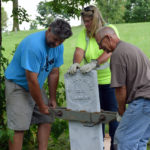- L. to r. Jeff Jackson, Ron Dostal, and Brian Orth set a marble, Veteran”'s marker. Tim McCall identified markers to replace or add and documented the installations. Photo by Tim McCall
- Veterans are gone but not forgotten by ongoing marker project. Some veterans never had markers. In June 2017,13 Civil War markers were set. Tim McCall, the cemetery”'s archivist, has discovered some who served but not identified as soldiers; the military unit of others remains unknown; thus no marker. Now, information on the internet makes more data available. Many people make this happen. The Daughters of Union Veterans contributed to setting cost. Brian Orth provided equipment and expertise. Mike Barth, the cemetery”'s caretaker, and Mpls. St. Dept. workers helped. L. to R. Brian Orth, Tami Jo Angrimson, and Jeff Jackson. Photo by Tim McCall
By Sue Hunter Weir
Seduction and broken promises
The child of Martha Anderson and Andrew G. Krogstad was stillborn on January 21, 1875. Two days later, Martha Anderson (sometimes referred to as Amondson) died from puerperal fever, a complication of childbirth; she was 26 years old. Her story was in its day an all too-common one””a story of seduction and broken promises.
Suit against prominent suitor
According to the complaint that she filed in court, Martha and Krogstad had met the previous summer. She was a Norwegian immigrant described by the press as “being of a spotless character.” Krogstad, also an immigrant, was president of the Norden Society, an important cultural organization for the area”'s Scandinavian community. Despite his prominence, the Minneapolis Tribune took a rather dim view of his character describing him as having a “reputation of being a rake.”
Krogstad had seduced Martha by promising to marry her. She pleaded with him of several occasions to make good on his promise but he refused. That left her no choice but to take him to court to try and get financial support for herself and her child. By going to court, her “ruin” became public knowledge. Krogstad was arrested and paid a bond of $1,000 (approximately $21,500 in 2017 dollars).
Krogstad was scheduled to appear in court on January 20th, the day before Martha gave birth to their stillborn child. His case was delayed because of Miss Anderson”'s confinement. Since her doctor was concerned that “she would follow her dead infant into the grave,” he gave permission for her testimony to be taken at her home.
On January 22nd, the Tribune noted that Krogstad”'s case had been held over until Wednesday of the following week, but noted that since the baby had died, the case against him was likely to be dismissed.
“Grave covers, suffering, grief, and shame.”
On the morning of January 23rd Martha died. The paper”'s dramatic announcement of her death stated that “now the grave will cover her suffering, her grief and her shame.”
Legal suit dropped and so too the “debaucher”
Krogstad”'s case was dropped but he did not go unpunished. The Norden Society dropped him as their president and launched its own investigation into the matter. He was suspended from his job at McConnell”'s Dry Goods Store. While the Tribune claimed that it had no interest in issuing a “wholesome denunciation” of Krogstad before he had had a public trial they said that his behavior could “only be explained by his being strongly impressed with a consciousness of his innocence, or by what circumstances lend to make appear a fact””that he is totally void of feeling and morally depraved.”
Crime of “bastardy” all too common.
Martha was 26 years old when she died but the papers referred to her as a “girl” suggesting that she was unsophisticated and vulnerable. She was one of many young women who had had similar experiences: “The debauching of innocent Scandinavian servant girls by this class of spruce young men is altogether too common in this city.” . Between December 1, 1875 and the end of March 1876, thirteen women filed charges against the fathers of their children, and the Tribune acknowledged that an even greater number of women didn”'t file charges because of the shame and humiliation of having gotten pregnant when they weren”'t married. The crime that the men in these cases were charged with was “bastardy.“
Few options, no social service
As a single mother who had made her living as a domestic servant, Martha had very few, if any, options. She had no family in the United States and there were no social programs to help her. Taking her child”'s father to court was likely the only way to ensure her own and her child”'s survival. The Tribune called for making “the penalty [for bastardy] commensurate with the enormity of the crime.”
After Martha died the charges against Krogstad were dropped. Rather than waiting to hear the judgment of the Norden Society, he skipped town””it was rumored that he went to California.
Potter”'s Field grave without marker
Martha Anderson and her child are buried in an unmarked grave in the paupers”' section of Minneapolis Pioneers and Soldiers Cemetery.
Sue Hunter Weir is a Phillips resident, The Alley Newspaper and Friends of the Cemetery Board Member.











